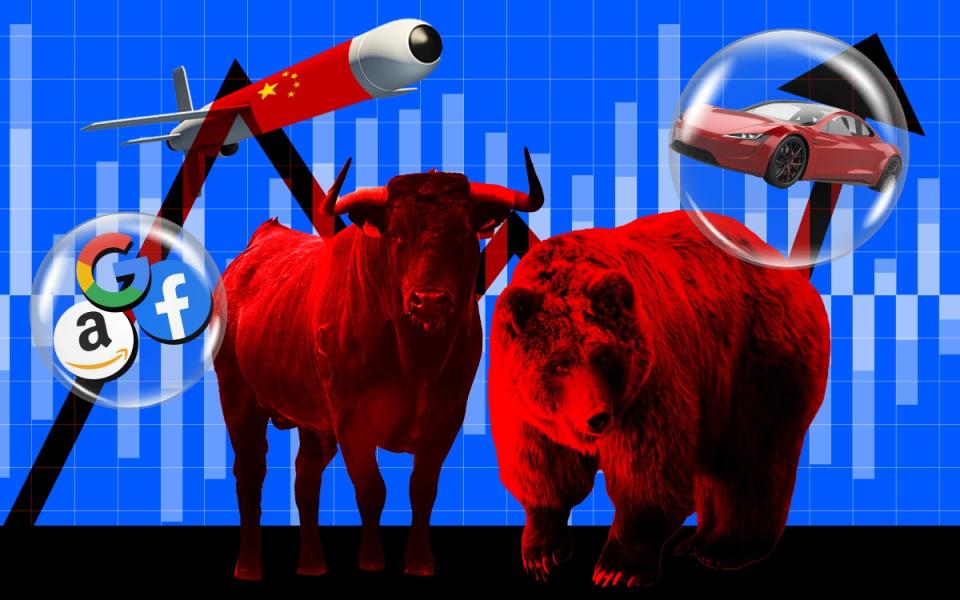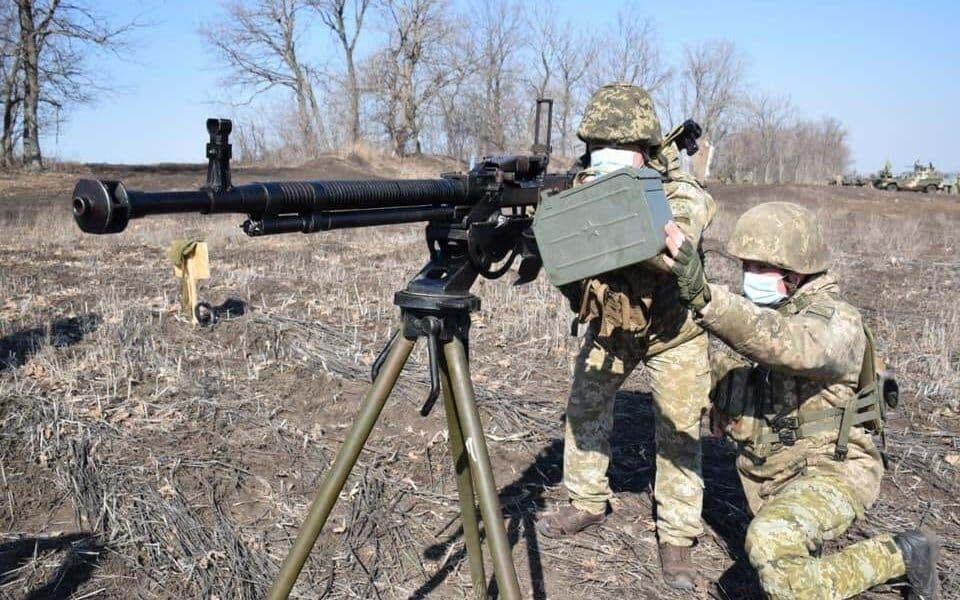Bull or bear? The dangers of the stock market gamble

Ambrose Evans-Pritchard: Risks are growing but this bull run is far from over
Great equity booms typically continue for a year or 18 months longer than a nervous rationalist believes possible.
It is expensive to pull the trigger too soon, and even more expensive to short stocks just because they look overpriced. That way lie margin calls. A strong nerve is required to stay the course amid the crowd pathologies of a late bubble.
When the end comes, it is because the US Federal Reserve has hit the brakes, or at least it has been for almost every cycle over the last century. The Fed raised interest rates by 400 basis points before the Lehman crisis, 350 points before the dotcom bust in 2000, 1,300 points during Paul Volcker’s war on inflation, and 800 points to rein in (belatedly) the “guns and butter” stimulus of the 1960s.
US rates are currently zero and the Fed has signalled its intention to keep them pinned to the floor through the Biden boom. It is still buying bonds and expanding its balance sheet, even though the broad M2 money supply has risen 27pc over the last year.
It is funding a third of the $3 trillion budget deficit with pure QE. It is accommodating the most radical fiscal experiment ever attempted in peace-time with the most radical monetary experiment to match. To modify a market dictum, don’t fight the Treasury and the Fed at the same time.
Equities can of course roll over of their own accord once prospective price-to-earnings ratios become hyper-inflated and earnings start to disappoint. This could soon happen as the global shortage of semiconductor chips and other key components squeezes profits.
But that is chiefly a story for specific stocks. Consensus US earnings forecasts (IBES) may look extreme at 27pc this year but so far they have beaten expectations. JP Morgan’s equity strategist Mislav Matejka says profit growth is typically leveraged six to seven times to GDP growth. A V-shaped economic rebound of 6.5pc this year – some say nearer 8pc – is stock market rocket fuel. “We expect another quarter where earnings releases act as a tailwind,” he said.
Yes, there are technical worries. Morgan Stanley’s equity bull Michael Wilson is getting edgy. He says stock markets are “discounting machines” and right now they are discounting large pockets of fatigue. The S&P 500 index has been hitting new records, but other indexes have not. “Underneath the surface, there has been a noticeable shift in leadership which could be telling us something about the reopening that may not be obvious,” he said.
Mr Wilson said the Russell 2000 index of small cap stocks has lagged the S&P 500 by 8pc over the last month. “When relative strength like this breaks down, we take notice. It is a potential early warning sign that the actual reopening of the economy will be more difficult than dreaming about it,” he said.
New share offerings – IPOs and their close cousins, Spacs – have underperformed the market by 20pc and are both down so far this year. “My experience is that when new issues underperform this much, it’s generally a leading indicator that equity markets will struggle more broadly,” he said.
So be careful of corporate leverage and momentum. We could be in for a choppy time. Mr Wilson thinks we are moving from early cycle to mid-cycle. I think this is an utterly deformed cycle that is already stretched, fraught with risk, and reliant on global debt creation beyond the point of solvency. But that does not mean the secular rally is over quite yet.

So what are the really big risks? The geopolitical nightmare is “Molotov-Ribbentrop” collusion by Russia and China, exposing the brittleness of the US-led western alliance with synchronised attacks on two fronts at once. We have a nasty whiff of it right now.
Vladimir Putin has massed 28 tactical battalions on the Ukrainian border, backed by heavy armour and short-range ballistic missiles. It is the biggest military build-up since the invasion of Crimea in 2014. The Kremlin has threatened to intervene to stop what it calls a Srebrenica-style massacre of ethnic Russians in the Donbass.
China is sending warplanes into Taiwanese airspace, with warnings that the Kuomintang island will “not stand a chance” in an invasion. US Secretary of State Antony Blinken has been forced to issue a categorical warning, if not quite a red line. “It would be a serious mistake for anyone to try to change the existing status quo by force,” he said.
The sabre-rattling in both cases aims to test Joe Biden, and to test whether Europe has any strategic backbone. But is the threat sufficiently credible at this stage to justify defensive action by investors? No, it is not.
Ukraine is better armed today. Seven years of weaker oil prices have taken the edge off Vladimir Putin’s military machine. The US could bleed Russia dry in a protracted proxy conflict by supplying weapons to Kiev, raising the cost of intervention for Moscow by “Reagan Doctrine” methods. China might find an occupation of Taiwan hard to achieve, and indigestible if achieved. Nothing would be more perilous for the Communist Party than a failed amphibious assault.
One thing I have learned covering the intersection of world affairs, economics, and markets for almost 40 years is that political black swan events are impossible to price, and are usually not worth trying to anticipate. They mostly come to nothing.
There are other more plausible risks to think about. One is that debt vigilantes will demand a much higher rate of return to absorb Joe Biden’s bond issuance, and a higher premium above that to cover Jay Powell’s inflation risk. Investors have already lost 19pc on holdings of 30-year US Treasuries over the last nine months. The haircut in the first quarter was the worst since 1919. It is no stealth expropriation. It is in plain view.
JP Morgan’s Jamie Dimon says you do not want to be the last person holding bonds when the economy overheats. “I wouldn't touch them with a 10-foot pole,” he said.
“Why in the world would you own bonds?” asks Ray Dalio from Bridgewater, founder of Wall Street’s biggest hedge fund. He fears a “run on the bank” scenario where confidence snaps and bond investors rush for the exits, setting off an uncontrollable feedback loop. “When such a dynamic occurs there is no stopping it,” he said.
The pattern through the centuries is that it ends in either runaway inflation or in debt-restructuring, accompanied by capital controls and ferocious financial repression. “Such moves would signal the beginning of the very last and most disruptive stage of the long-term debt cycle,” he said
Mr Dalio loves to luxuriate in the great sweep of history. Berkshire Hathaway’s Warren Buffett says more prosaically that the bond market is “not the place to be these days.” He advises retirees and fixed-income investors not to try to “juice the pathetic returns” by switching to riskier debt offering higher yields. That will end badly.
Bond bulls are taking the other side of the trade, betting that rising yields in a global system acutely sensitive to borrowing costs will short-circuit the recovery. This in turn will cause a lurch back into safe-haven sovereign debt. Current market folklore is that trouble will start in earnest when 10-year US Treasuries punch through 2pc. They closed on Monday at 1.7pc.
My view is that the pain threshold is higher. We are in a pattern where each jump in yields causes a short equity hiccup until investors get used to the new level. It keeps climbing higher up a wall of worry.
The more dangerous risk lies in Europe, and the trouble there is likely to hit earlier. The paradox of recovery is that it brings the eurozone’s festering North-South incompatibility to a head. Reflation robs the European Central Bank of its monetary, legal, and political justification for continuing to finance the entire debt issuance of Italy and Club Med. My premise is that Italy is essentially insolvent the moment the central bank shield is removed. Post-pandemic debt of 160pc of GDP ratio has crossed the line.
The current QE programme runs until March 2022. There is going to be an almighty battle within the ECB’s governing council as this cliff-edge draws closer. Markets assume that it will be resolved with a trademark euro-fudge, keeping the game going for a bit longer. Perhaps. But before there can be a solution there will be another eurozone debt scare.
That is not a problem for this month, or this quarter. We can cross that bridge when we get there in the late autumn. Until then, lie back and enjoy the surging global money supply.

Jeremy Warner: A bust is coming. It’s only a question of when
Stock markets tend to operate on a different cycle to that of the real economy. It is therefore possible to be ultra-bullish on the economy, but relatively bearish on stock markets. I’m one of those pundits.
The next several years, I believe, are going to be very strong for the economy. This is what Jamie Dimon, chief executive of JP Morgan Chase – who broadly reflects the Wall Street consensus – had to say on the matter last week. “I have little doubt with excess savings, new stimulus savings, huge deficit spending, more QE, a new potential infrastructure bill, a successful vaccine and euphoria around the end of the pandemic, the US economy will likely boom.”
Much the same observation can be made about the UK, and even the EU, now that it is finally getting its act together on vaccine rollout. There is of course nothing in the EU to compare with Biden’s giant fiscal stimulus packages, so the European economy isn’t going to be anywhere near as strong as the US.
Nonetheless, most of the major European economies should also have recovered all the growth lost to Covid by the end of next year, ending up no poorer than was being forecast before the pandemic began. That’s what the International Monetary Fund is forecasting in its latest World Economic Outlook, and there is no obvious reason to disagree. Given where we were only a few months ago, that would be a remarkable outcome.
But here’s the point; all that recovery, and quite a bit more I would suggest, is already in the price. As far as many stock markets are concerned, it is as if the disease never happened, despite its continued and economically destructive prevalence in many parts of the world. Actually it’s even more striking than that. The US high tech market, Nasdaq is an astonishing 42pc higher than its pre-pandemic level little more than a year ago, and that too was at the time a record high. Even acknowledging that the pandemic has put a rocket under the economy’s transition into the digital age, that’s a hell of a run (see chart below).
All the so-called FAANGS – Facebook, Amazon, Apple, Google (Alphabet) and Netflix (we might also add Microsoft) – are trading at or close to their all-time highs. But nor is this soaraway performance confined just to tech stocks. The more representative S&P 500 is 22pc up on its pre-pandemic high, and even Britain’s own, tech-lite, FTSE All Share index – still weighed low by Brexit worries – is now not far off February 2020 levels, before Covid became established.
As for US tech, it seems almost entirely immune to bad news. Joe Biden’s tax assault on corporate America has been shrugged aside as if of no consequence. Likewise, the administration’s growing antitrust sabre rattling.
Investors have become like the ageing playboy millionaire Osgood in Some Like it Hot. They are impervious to persuasion. There is nothing Daphne (Jack Lemmon dressed in drag) can say to Osgood to put him off when he proposes marriage in the closing sequence of the film. I’m the wrong size for your mother’s wedding dress, Daphne protests. We can have it altered, Osgood replies. I’m not a natural blonde; doesn’t matter. I smoke all the time; I don’t care. I have a terrible past; I forgive you. I can never have children; we can adopt. But you don’t understand, Daphne cries, ripping off his wig. I’m a man. Well, nobody’s perfect, says Osgood.
When it comes to overvalued stock markets, indeed they are not. All buffed up with hot air, there is a reason for their state of insouciance – central bank money printing and ultra-low interest rates. Lack of viable alternatives has made stock markets the destination of choice for all that newly printed money, driving them into bubble territory.
The question of the moment is whether rising interest rates, as the economy strengthens, will finally cause reality to come crashing home. The yield on benchmark 10-year Treasuries has been creeping up for the best part of a year now, and at close to 1.7pc is approaching the 2pc level that some regard as a natural inflection point. Other than it being a nice round number, I’m not sure why it should be 2pc, but in any case that’s the level at which some pundits believe equities will lose their attraction relative to bonds, prompting a rotation out of stocks and shares.
But you can equally well read rising government bond yields the other way – as a sign of emerging inflation and credit risk. A little bit of inflation is generally regarded as good for equities, but too much and it means central banks have to slam on the brakes by raising overnight rates. Rarely do they manage a soft landing. Nearly always they leave it too late, so that when they do act, they have to press down hard, causing the economy to stall.
If it looks like a bubble... Even so, it’s a mug’s game trying to predict when it might deflate. If something cannot go on forever, it will stop, President Nixon’s economic adviser, Herb Stein, famously said. But however wise they might be, nobody can tell you when. Also worth remembering is that over time, equities have historically always delivered superior returns; it doesn’t pay to be wholly out of equities for long.
All the same, we’ve not had a bad crash for a while now. Thanks to unprecedented policy action, Covid has not proved to be the giant bubble popper everyone thought it might be. But if the upshot of all that policy action is a boom in the real economy, then eventually there will be a bust. Again, it is only a matter of when.
This article is an extract from The Telegraph’s Economic Intelligence newsletter. Sign up here to get exclusive insight from two of the UK’s leading economic commentators – Ambrose Evans-Pritchard and Jeremy Warner – delivered direct to your inbox every Tuesday.

 Yahoo Finance
Yahoo Finance 